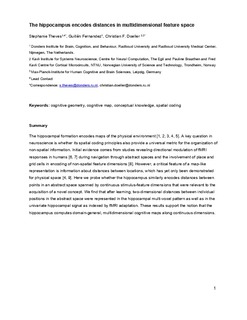| dc.contributor.author | Theves, Stephanie | |
| dc.contributor.author | Fernandez, Guillen | |
| dc.contributor.author | Doeller, Christian Fritz Andreas | |
| dc.date.accessioned | 2019-12-18T15:07:37Z | |
| dc.date.available | 2019-12-18T15:07:37Z | |
| dc.date.created | 2019-08-15T15:29:27Z | |
| dc.date.issued | 2019 | |
| dc.identifier.citation | Current Biology. 2019, 29 (7), 1226-1231.e3. | nb_NO |
| dc.identifier.issn | 0960-9822 | |
| dc.identifier.uri | http://hdl.handle.net/11250/2634054 | |
| dc.description.abstract | The hippocampal formation encodes maps of the physical environment [1, 2, 3, 4, 5]. A key question in neuroscience is whether its spatial coding principles also provide a universal metric for the organization of non-spatial information. Initial evidence comes from studies revealing directional modulation of fMRI responses in humans [6, 7] during navigation through abstract spaces and the involvement of place and grid cells in encoding of non-spatial feature dimensions [8]. However, a critical feature of a map-like representation is information about distances between locations, which has yet only been demonstrated for physical space [4, 9]. Here, we probe whether the hippocampus similarly encodes distances between points in an abstract space spanned by continuous stimulus-feature dimensions that were relevant to the acquisition of a novel concept. We find that, after learning, two-dimensional distances between individual positions in the abstract space were represented in the hippocampal multivoxel pattern as well as in the univariate hippocampal signal as indexed by fMRI adaptation. These results support the notion that the hippocampus computes domain-general, multidimensional cognitive maps along continuous dimensions. | nb_NO |
| dc.language.iso | eng | nb_NO |
| dc.publisher | Elsevier | nb_NO |
| dc.rights | Attribution-NonCommercial-NoDerivatives 4.0 Internasjonal | * |
| dc.rights.uri | http://creativecommons.org/licenses/by-nc-nd/4.0/deed.no | * |
| dc.title | The Hippocampus Encodes Distances in Multidimensional Feature Space | nb_NO |
| dc.type | Journal article | nb_NO |
| dc.type | Peer reviewed | nb_NO |
| dc.description.version | acceptedVersion | nb_NO |
| dc.source.pagenumber | 1226-1231.e3 | nb_NO |
| dc.source.volume | 29 | nb_NO |
| dc.source.journal | Current Biology | nb_NO |
| dc.source.issue | 7 | nb_NO |
| dc.identifier.doi | 10.1016/j.cub.2019.02.035 | |
| dc.identifier.cristin | 1716217 | |
| dc.description.localcode | © 2019. This is the authors’ accepted and refereed manuscript to the article. Locked until 21.3.2020 due to copyright restrictions. This manuscript version is made available under the CC-BY-NC-ND 4.0 license http://creativecommons.org/licenses/by-nc-nd/4.0/ | nb_NO |
| cristin.unitcode | 194,65,60,0 | |
| cristin.unitname | Kavliinstitutt for nevrovitenskap | |
| cristin.ispublished | true | |
| cristin.fulltext | postprint | |
| cristin.qualitycode | 2 | |

